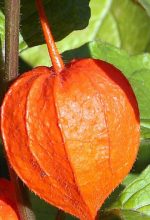 Also called bladder cherry and strawberry ground cherry, this herbaceous perennial is native to southern Europe and parts of Asia. It is a member of the nightshade family, Solonaceae, that also includes petunia, tomato and tobacco. Plants grow 1-2′ tall from a rhizomatous root system and have opposite arrow-shaped leaves that are spirally arranged and up to 5″ long. The 1″ wide flowers have a 5 lobed white corolla surrounding yellow stamens and are carried in the axils of the upper leaves in summer. The edible but rarely eaten fruit is small and cherry-like and is surrounded by a papery green husk up to 2″ long that turns bright orange in late summer. Plants are grown for these attractive lantern like fruit coverings that are beautiful in both live and dried arrangements. Chinese lantern selfseeds and spreads so aggressively by rhizomes that it can become invasive and is not suitable for the border. The genus name, Physalis, comes from the Greek word physa meaning bladder and refers to the inflated husk. The specific epithet, alkekengi, comes from an Arabic word meaning bladder cherry.
Also called bladder cherry and strawberry ground cherry, this herbaceous perennial is native to southern Europe and parts of Asia. It is a member of the nightshade family, Solonaceae, that also includes petunia, tomato and tobacco. Plants grow 1-2′ tall from a rhizomatous root system and have opposite arrow-shaped leaves that are spirally arranged and up to 5″ long. The 1″ wide flowers have a 5 lobed white corolla surrounding yellow stamens and are carried in the axils of the upper leaves in summer. The edible but rarely eaten fruit is small and cherry-like and is surrounded by a papery green husk up to 2″ long that turns bright orange in late summer. Plants are grown for these attractive lantern like fruit coverings that are beautiful in both live and dried arrangements. Chinese lantern selfseeds and spreads so aggressively by rhizomes that it can become invasive and is not suitable for the border. The genus name, Physalis, comes from the Greek word physa meaning bladder and refers to the inflated husk. The specific epithet, alkekengi, comes from an Arabic word meaning bladder cherry.
Bloom: Inconspicuous 1″ wide flowers with a 5 lobed white corolla surrounding yellow stamens; carried in the axils of the upper leaves in summer.
Size: 1-2′ H x 1-2′ W
Light: Full sun
Soil: Average, consistently moist, well-drained
Hardiness: Zones 3-9
Care: Fertilize in spring but avoid excessive applications that may favor vegetative growth over flowering. Contain root system to avoid invasiveness.
Pests and Diseases: Aphids, caterpillars
Propagation: Seed, division in spring
Companion Plants: Not suitable for the garden because of invasiveness.
Outstanding Selections:
‘Gigantea’ (large fruits and flowers)
‘Pygmea’ (12-15″ tall)